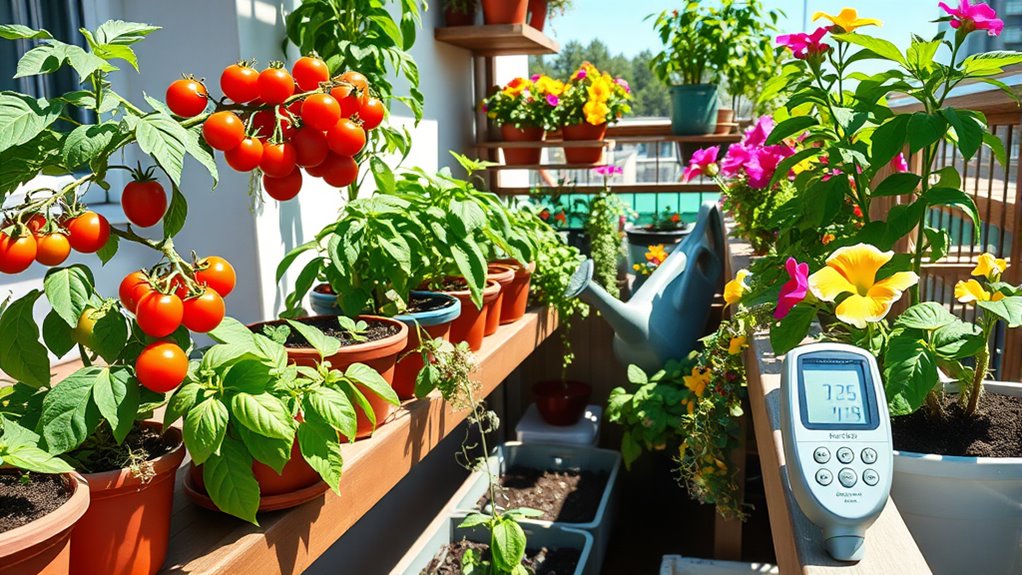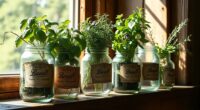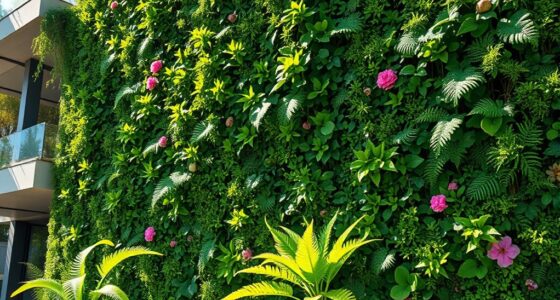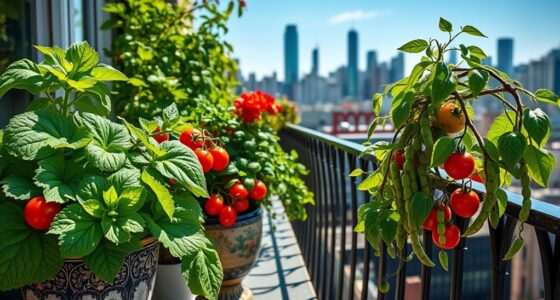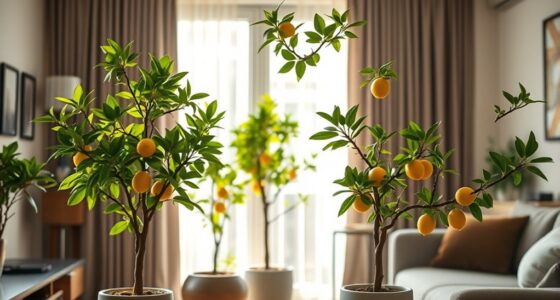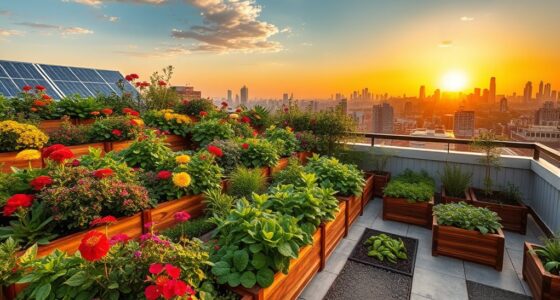To troubleshoot common container gardening problems, start by checking soil moisture regularly—avoid over or under-watering—then make certain your containers have proper drainage to prevent root rot. Watch for pests and fungal issues, and treat them early with organic solutions. Choose the right-sized containers with quality soil, and position plants where they get enough sunlight and warmth. Supporting and pruning your plants helps prevent disease, and adjusting watering and fertilizing seasonally keeps them healthy. More tips await if you continue exploring.
Key Takeaways
- Check soil moisture regularly to prevent overwatering or underwatering, adjusting watering schedule accordingly.
- Ensure containers have proper drainage holes and use well-draining soil to avoid root rot.
- Inspect plants frequently for pests and treat infestations early with organic solutions like neem oil.
- Maintain adequate airflow by spacing containers properly and pruning to reduce humidity and disease risk.
- Adjust sunlight exposure and watering routines seasonally to match plant needs and prevent stress.
Identifying Signs of Overwatering and Underwatering
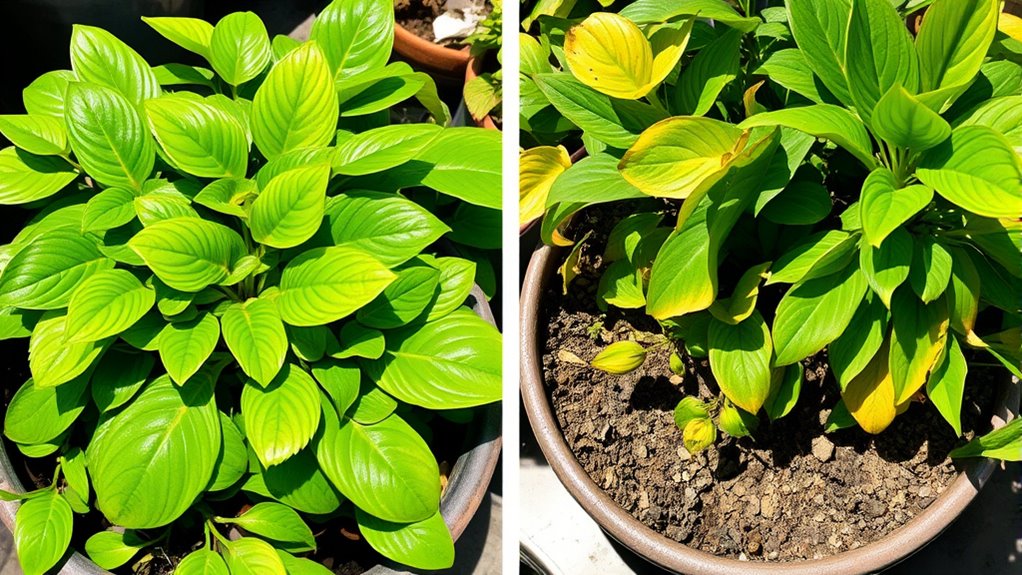
One of the most common container gardening problems is misjudging when to water your plants. Overwatering causes moisture to sit in the soil, leading to wilting foliage despite the soil feeling moist. Yellowing leaves and soft, mushy stems are clear signs of too much water, which can also foster fungal diseases. Proper watering techniques are essential for healthy plant growth and can be supported by understanding plant-specific hydration needs. Additionally, using appropriate soil mixes can improve drainage and prevent overwatering issues. Incorporating data-driven strategies can help you develop a consistent watering schedule based on your plants’ needs. To further optimize watering, understanding watering techniques can help you apply the right amount of water without overdoing it. Conversely, underwatering dries out the soil, making leaves brittle and causing the soil to pull away from the container edges. To prevent these issues, check the soil moisture regularly—use your finger or a moisture meter. Water only when the top inch of soil feels dry. This careful monitoring helps you balance moisture levels, avoiding the pitfalls of over- and underwatering, and keeps your plants healthy.
Ensuring Proper Drainage to Prevent Root Rot
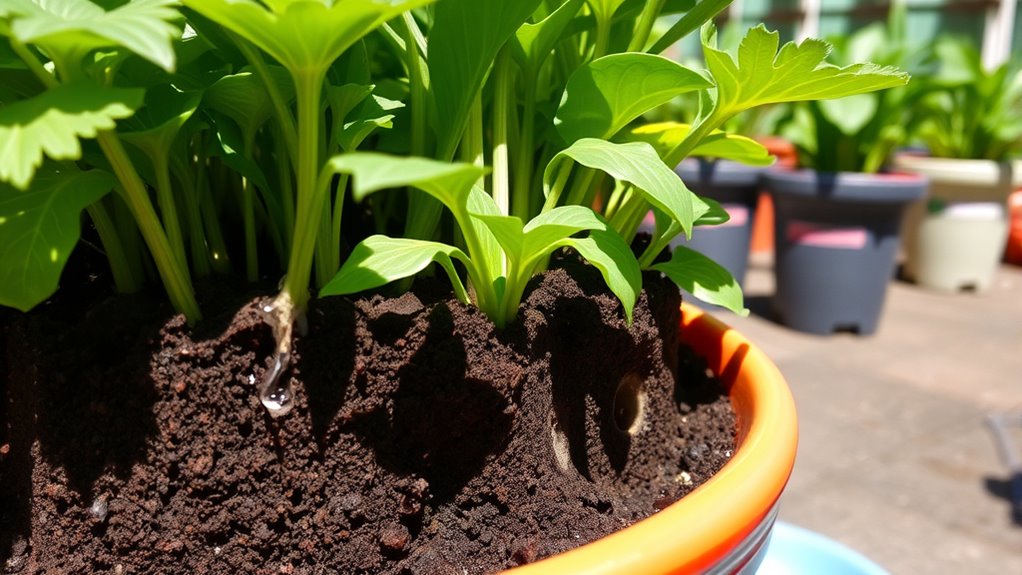
Proper drainage is essential for healthy container plants, as excess water can quickly lead to root rot and other diseases. Make sure each container has drainage holes to let surplus water escape, preventing waterlogging. Placing a layer of coarse gravel or broken pottery at the bottom can help improve drainage and keep soil from clogging the holes. Avoid overfilling the container with soil; leave about an inch of space at the top to facilitate proper water flow. Use a well-draining soil mix, such as one with perlite or sand, to promote healthy root aeration. Regularly check and clear any clogged drainage holes to ensure water flows freely. Proper drainage is vital for preventing water retention around roots, which reduces the risk of root rot and keeps your plants healthy. Additionally, ensuring adequate ventilation around the container can help prevent excess moisture buildup and promote healthy plant growth, as ventilation also influences soil aeration and moisture levels. Incorporating temperature regulation measures can further enhance plant health by preventing overheating and stress in containers. Maintaining consistent watering schedules helps avoid both overwatering and underwatering, contributing to optimal plant health.
Recognizing and Managing Pest Infestations
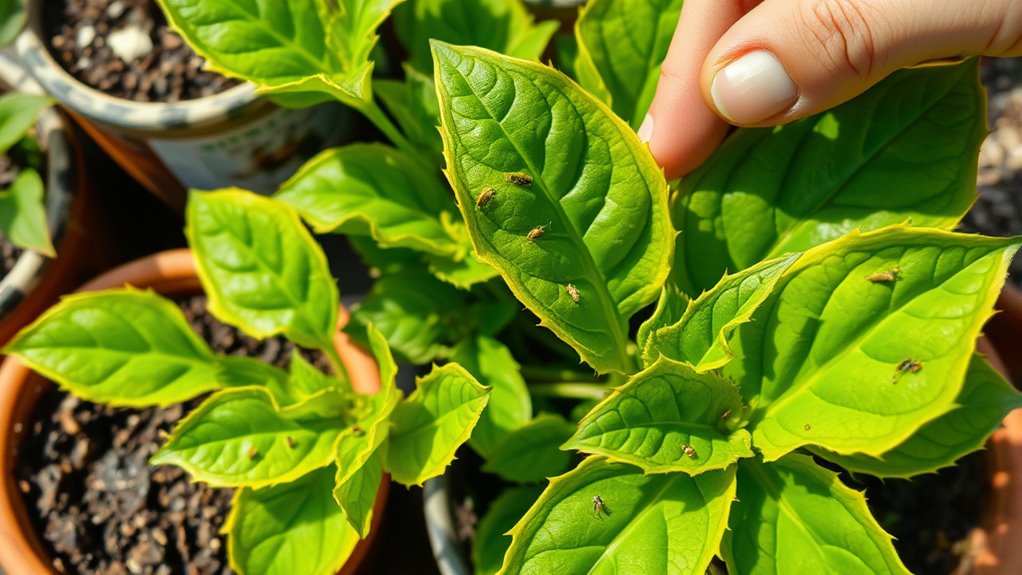
Recognizing and managing pest infestations is essential for maintaining healthy container plants. Pests like aphids, whiteflies, spider mites, and slugs can cause significant damage, including leaf holes, webbing, and stunted growth. Regularly inspect your plants for visible pests or signs such as sticky residue or holes. Early detection is key to controlling an infestation before it spreads. Use insecticidal soap or neem oil directly on pests to disrupt their life cycle without harming beneficial insects. In addition, understanding credit card terms can help gardeners manage expenses related to pest control supplies and tools. Incorporate companion plants like marigolds or basil to naturally repel pests. Physical barriers such as sticky traps or row covers can also prevent pests from reaching your plants. Staying vigilant and employing these techniques helps keep pests and diseases at bay, ensuring healthy, thriving container gardens.
Addressing Fungal Diseases and Mold Issues

Fungal diseases and mold issues can quickly undermine the health of your container garden if left unchecked. To prevent these problems, consider these steps:
- Ensure proper air circulation by spacing containers well and avoiding overcrowding, which reduces humidity that fosters fungal growth. Proper airflow is essential for maintaining a healthy environment and preventing mold development.
- Water plants at the base instead of overhead, preventing excess moisture on the foliage and soil surface that encourages mold issues.
- Use sterile, well-draining potting mixes, and sterilize tools and containers with a bleach solution before planting or replanting. Additionally, selecting appropriate soil can significantly reduce the risk of fungal contamination.
- Remove and dispose of infected plant material immediately to stop the spread of fungal spores within your containers and to neighboring plants.
- Recognize that trust issues can sometimes develop if fungal problems are ignored, as they damage plant health and vitality, mirroring relationship challenges.
Applying organic fungicides like neem oil at the first signs of fungal diseases can also help maintain plant health.
Choosing the Right Container Size and Material
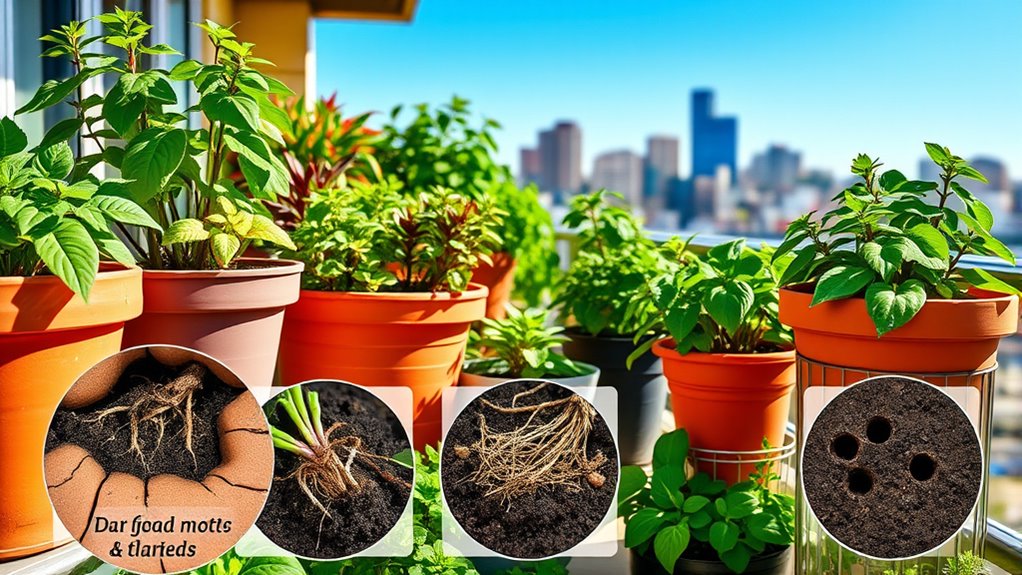
Choosing the right container size and material is essential for healthy plant growth. Select a container at least twice the size of your plant’s mature root ball to prevent root binding and encourage strong roots. Proper sizing helps maintain optimal soil moisture and aeration, which are critical for plant health. For vegetables like garlic, lettuce, and herbs, a depth of 8 inches suffices. However, for crops such as carrots and broccoli, opt for 10 inches or more. Material selection impacts water retention and watering frequency. Plastic retains moisture well, while clay or terracotta dries faster and needs more frequent watering. Guarantee your container has adequate drainage holes to prevent water buildup and root rot, especially in larger or heavier pots. Lightweight, durable containers designed for gardening make mobility easier and withstand outdoor conditions, supporting your plants’ healthy development. Additionally, considering container material properties can help you choose the best option based on your climate and watering habits. Incorporating automation in watering can also assist in maintaining consistent moisture levels, especially in larger setups. Properly selecting containers based on plant growth requirements ensures optimal development and reduces common issues like overwatering or drought stress.
Improving Soil Quality and Fertilization Practices

Using the right container size and material sets the foundation for healthy plants, but maintaining soil quality and proper fertilization practices is equally important. To boost soil quality, choose a high-quality, lightweight, well-draining potting mix enriched with compost or slow-release fertilizers. Incorporating diverse designs in planters can also influence soil moisture retention and aeration, benefiting plant health. Additionally, understanding mindfulness can help you stay attentive to your plants’ needs and respond proactively to signs of distress. Being aware of soil health and its impact on plant growth can further improve your gardening success. Here are some tips to improve your soil and fertilization routine:
- Replace the top 6 inches of soil annually to replenish nutrients and prevent compaction.
- Incorporate organic fertilizers like fish emulsion or compost tea regularly, especially for herbs and vegetables.
- Monitor soil pH and adjust with lime or sulfur to stay within the ideal range of 6.0 to 7.0.
- Avoid garden soil in containers, as it’s dense, poorly drained, and may introduce pests or diseases.
Maintaining Adequate Sunlight and Temperature Conditions
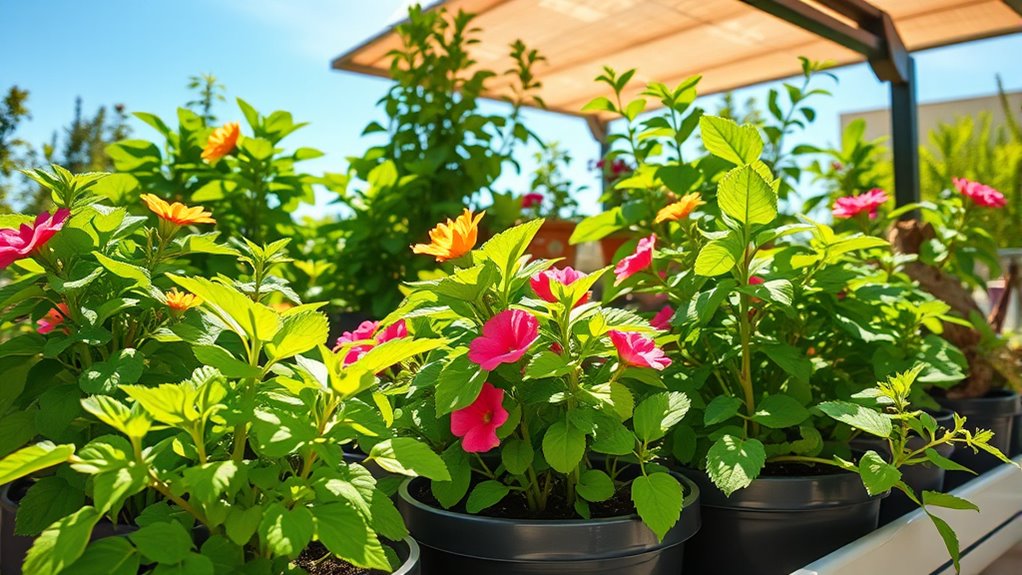
Making sure your container plants receive adequate sunlight and maintain proper temperature conditions is essential for healthy growth. Most vegetables and herbs need at least 6 hours of direct full sun daily. During peak summer, move containers to shade or use shade covers to prevent heat stress and sun scorch. Use local climate data to choose ideal planting times, avoiding frost and extreme heat. In areas with intense sunlight, consider reflective surfaces or light-colored containers to reduce heat absorption. Regularly monitor seasonal sunlight patterns and adjust container placement to maximize light exposure throughout the growing season. Incorporate proper light management techniques to further optimize plant health and productivity. Ensuring proper temperature control helps prevent plant stress, promote vigorous growth, and ensure a bountiful harvest. Understanding frost dates can help you plan planting and protection strategies to extend your growing season. Additionally, paying attention to air circulation can reduce the risk of fungal diseases and promote overall plant health. Proper watering practices are also vital to prevent both drought stress and waterlogging, which can harm plants. Keep these factors in check for thriving container gardens.
Supporting Plants for Healthy Growth and Fruit Development
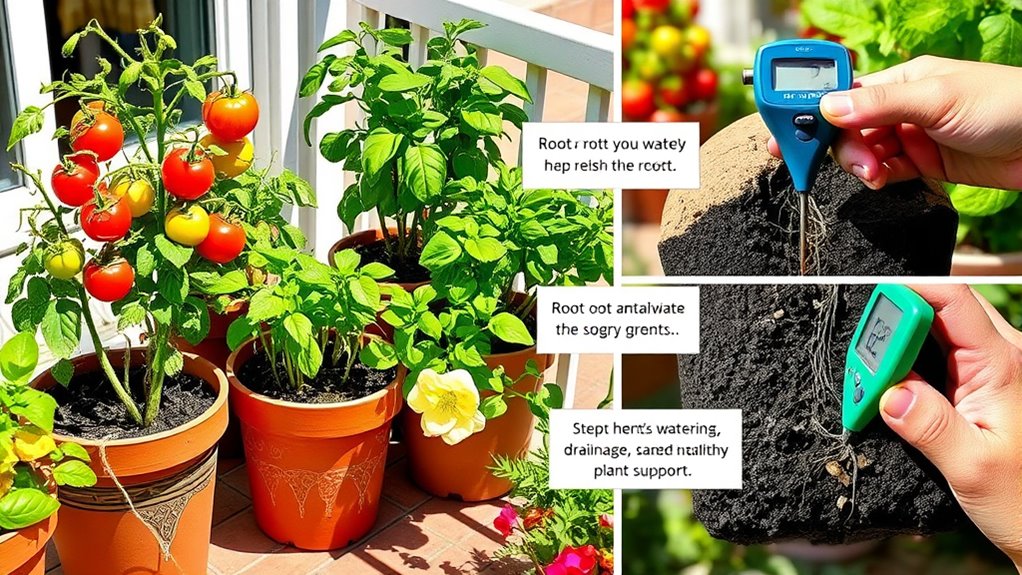
Using support structures like stakes, cages, and trellises helps keep your plants upright and healthy. Installing them early guarantees your crops won’t sprawl, reducing disease and making harvests easier. Proper spacing and support promote better airflow, sunlight, and higher yields. Additionally, choosing the right support materials can enhance plant stability and longevity.
Early Support Structures
Plant support structures like stakes, cages, and trellises should be installed at the time of planting to prevent root damage and provide stable support. Early support structures help keep plants upright, shape them properly, and enhance air circulation around foliage.
This reduces the risk of stem cracking, disease, and pests. Using support structures from the start also minimizes the need for corrective measures later, promoting healthier growth and higher yields.
Here are four key benefits:
- Prevent root damage during planting
- Provide stable plant support for heavy or sprawling plants
- Improve air circulation, reducing disease risk
- Keep fruits off the soil, preventing rot and pests
Proper Plant Spacing
Proper plant spacing is essential for healthy growth and abundant fruit production in container gardening. When plants are spaced correctly, they’ve enough room for roots to develop without overcrowding, which helps prevent disease and promotes stronger plant growth.
Adequate spacing also allows for better airflow around each plant, reducing humidity and lowering the risk of fungal infections. For sprawling or heavy-fruit plants, early support with stakes, cages, or trellises keeps stems upright and encourages better fruit development.
Thinning seedlings to the proper distance ensures each plant gets enough light, water, and nutrients, leading to healthier growth. Additionally, proper spacing makes maintenance, watering, and harvesting more manageable, ultimately increasing your container garden’s productivity and success.
Use of Trellises and Cages
Trellises and cages play a crucial role in supporting vining and sprawling plants like tomatoes, cucumbers, and beans, preventing stems from cracking and lowering the risk of disease. Proper support structures help maintain plant stability, improving airflow and reducing fungal issues.
When installing trellises or cages, consider these tips:
- Choose the right support size and type based on your plant’s height and weight.
- Install supports at planting time for stability and to shape the plant early.
- Use adjustable or removable supports for easier pruning and maintenance.
- Keep fruits off the soil to prevent rot and pest infestation, making harvest simpler.
Using the right support structures enhances plant health, encourages healthy growth, and maximizes fruit production through better airflow and plant stability.
Thinning and Pruning to Promote Airflow and Prevent Disease
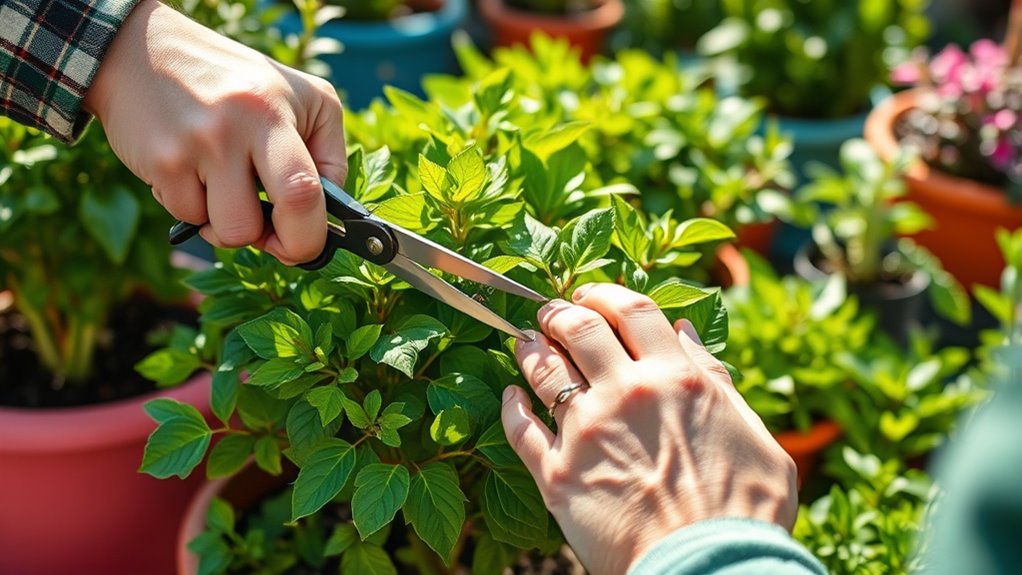
Thinning overcrowded plants and pruning excess growth are essential steps to improve airflow within your container garden. Thinning involves removing weaker seedlings to create proper spacing, which reduces humidity and the risk of fungal disease.
Pruning back excess growth allows better light penetration and airflow around stems and leaves, promoting healthier development and preventing stem rot. Regularly removing dead or diseased leaves minimizes pathogen spread and keeps plants vigorous.
Proper thinning helps prevent pests that thrive in dense foliage, further protecting your garden. Supporting plants with stakes or cages early on also encourages airflow and reduces mechanical stress from overcrowding.
Adjusting Watering and Feeding Schedules Seasonally
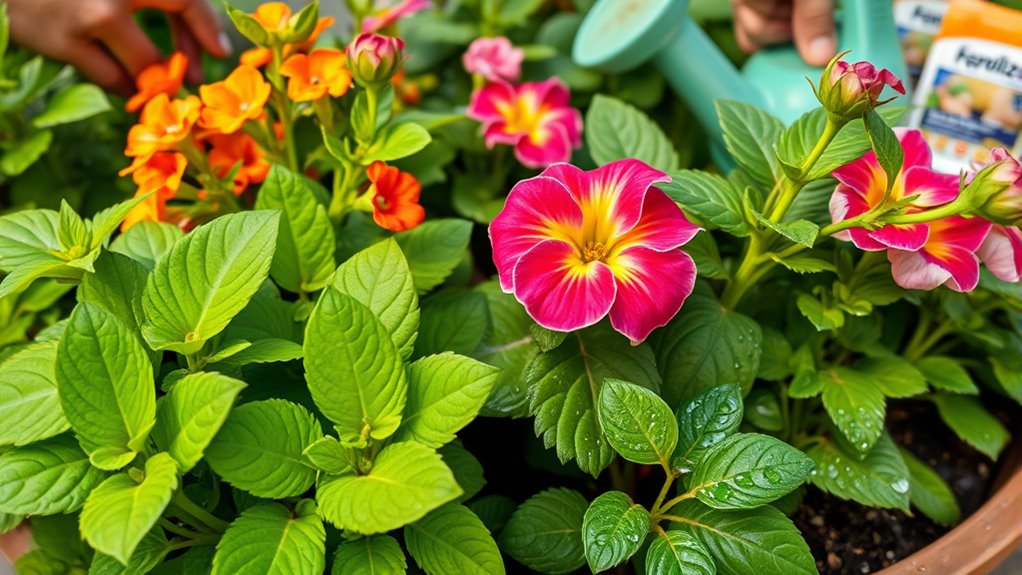
Adjusting your watering and feeding schedules throughout the year is essential to keep your container garden healthy. Seasonal adjustments help guarantee your plants get the right moisture and nutrients at the right times.
- Increase watering frequency during hot summer months to combat higher evaporation, keeping soil moist but not waterlogged.
- Reduce watering and fertilizing in fall to prevent overfeeding and excess moisture as plants slow growth or enter dormancy.
- Adjust fertilizer application based on seasonal growth patterns—more in spring and early summer, less in cooler months.
- Use mulching or covers to retain soil moisture and regulate temperature, especially in winter, reducing the need for frequent watering.
Monitoring plant health helps you modify routines, ensuring your container garden thrives year-round.
Frequently Asked Questions
What Is the Most Common Problem With Caring for Indoor Container Plants?
Ever wonder what’s the biggest challenge when caring for indoor container plants? It’s overwatering. You might think more water helps, but it actually causes root rot and fungal issues because the soil stays too wet and drains poorly.
To keep your plants healthy, you need to find the right balance—watering when the topsoil feels dry—and guarantee proper drainage. That way, your plants thrive instead of suffer.
Why Is My Container Garden Not Growing?
If your container garden isn’t growing, you mightn’t be giving your plants enough light, especially if they get less than six hours of full sun daily.
Overcrowding can also restrict root growth, and poor soil or irregular watering can cause nutrient deficiencies or stress.
Make sure your containers are appropriately sized for your plants and that you’re fertilizing regularly.
Adjusting these factors should help your garden thrive.
Should I Water My Container Garden Every Day?
You might wonder if you should water your container garden every day. It depends on factors like plant type, container size, and weather.
Check the soil moisture by inserting your finger about an inch deep; if it feels dry, it’s time to water.
Avoid daily watering if the soil stays moist, as overwatering can cause root rot.
Use self-watering containers or adjust based on seasonal conditions for best results.
What Is the Rule of Thumb for Container Gardening?
When it comes to container gardening, size really does matter, so don’t bite off more than you can chew. A good rule of thumb is to pick a pot at least twice as wide as the plant’s mature root ball, with at least 8-12 inches of depth for vegetables and herbs.
Make sure it has drainage holes, and space multiple plants properly to keep everything thriving. Balance size and practicality for the best results.
Conclusion
Now that you know the common pitfalls, your container garden is poised for success. But beware—hidden issues can still lurk beneath the surface, waiting to disrupt your plants’ health. Will your next watering tip tip the balance, or will that sneaky pest find its way in? Stay vigilant, adapt as needed, and your garden’s vibrant life could surprise you when you least expect it. The secret to thriving plants is in your hands—are you ready?
